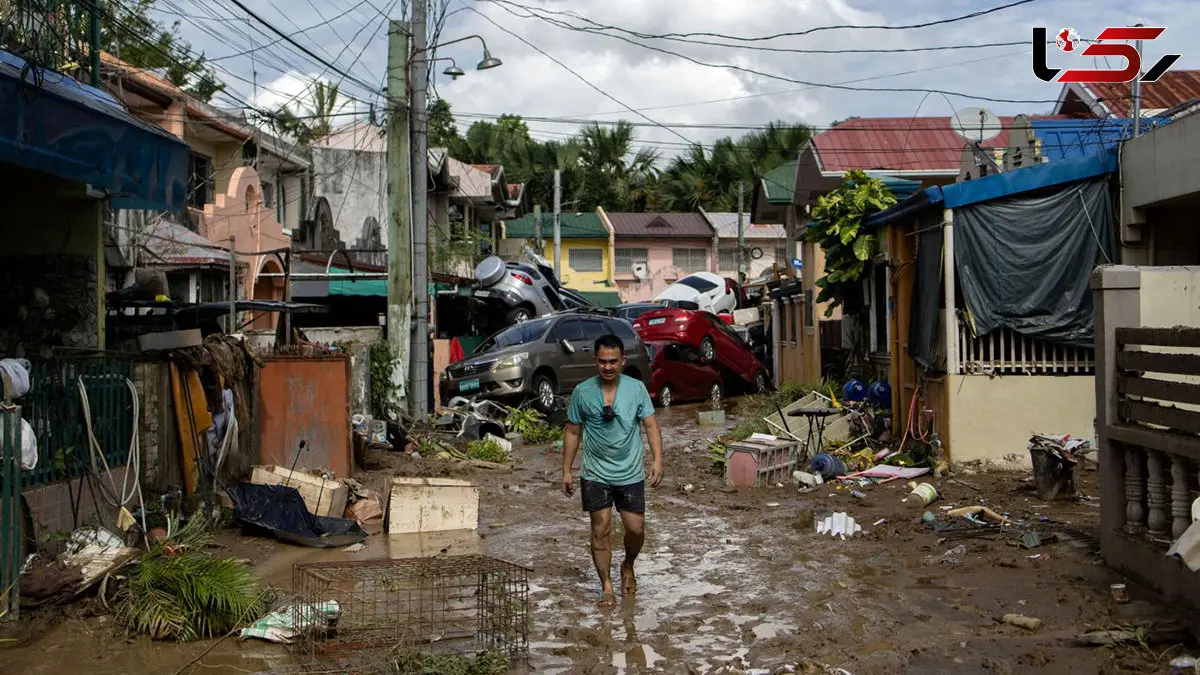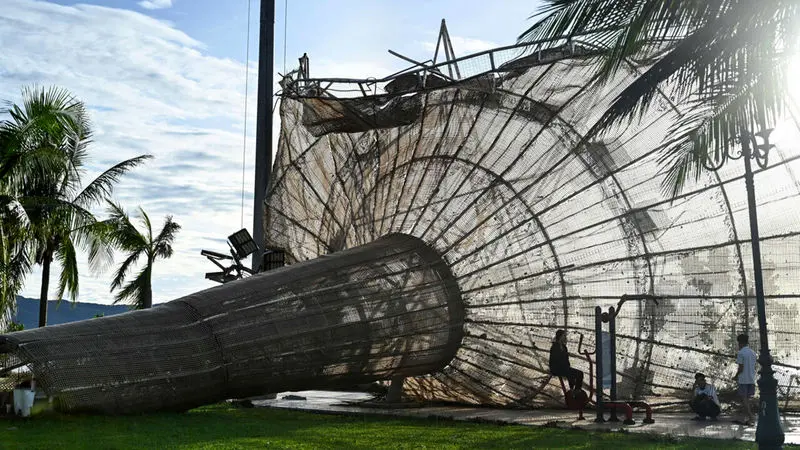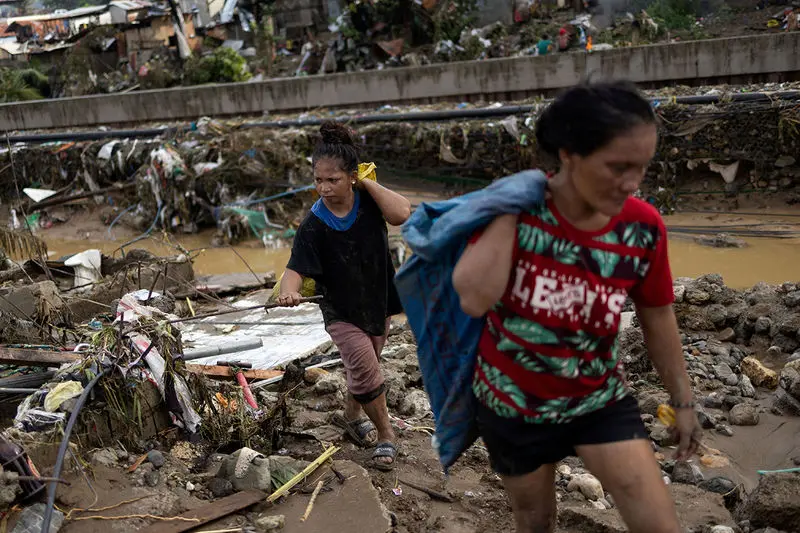Typhoon Kalmaegi batters Vietnam after leaving deadly trail across the Philippines
Rokna Social Desk: Typhoon Kalmaegi, one of the most powerful storms ever to hit Vietnam, tore through central parts of the country late Thursday after leaving nearly 200 dead and tens of thousands displaced in the Philippines, bringing torrential rains, fierce winds, and widespread devastation across the region.

Typhoon Kalmaegi tore through central Vietnam late Thursday, damaging homes, uprooting trees, and cutting power to more than a million people, after devastating the Philippines earlier in the week, where it claimed nearly 200 lives.
Among the strongest typhoons ever recorded in Vietnam, Kalmaegi unleashed torrential downpours and fierce winds on regions already inundated by record rainfall and severe flooding. In the Philippines, the storm carved a path of destruction across central provinces, flattening neighborhoods and forcing tens of thousands to flee their homes. Local authorities reported at least 188 deaths, most of them in the popular tourist province of Cebu.

Data from the U.S. National Oceanic and Atmospheric Administration (NOAA) showed Kalmaegi reached maximum sustained winds of 125 mph as it barreled toward Vietnam’s coast before weakening once it made landfall and moved inland. Scientists have repeatedly warned that human-driven climate change — for which industrialized nations bear greater historic responsibility — is amplifying both the intensity and frequency of storms that disproportionately devastate populations in the Global South.
In the Philippines, survivors have begun sifting through the ruins of their homes, salvaging what they can from the mud and debris as floodwaters recede, revealing the full scale of the destruction. Meanwhile, another tropical storm, Fung-Wong — known locally as Uwan — is strengthening and could reach Category 3 or 4 intensity over the weekend, threatening more floods across northern Luzon, according to the Joint Typhoon Warning Center.

In Vietnam, state media reported that at least five people were killed and seven injured in the storm. One person died when a house collapsed in the central region, while three others were reported missing after being swept into the sea off Ly Son Island in Quang Ngai province.
Heavy rain from Kalmaegi flooded coastal communities in Dak Lak province, where 354 mm (about one foot) of rainfall was recorded in just six hours, Vietnam News reported. More than 500,000 residents were evacuated — many by boat — as the country faced yet another natural disaster just a week after floods submerged historic sites including Hoi An and Hue. During those earlier floods, more than a dozen people died, and over 116,000 homes and 5,000 hectares of farmland were inundated, according to government data.
Kalmaegi is expected to continue weakening as it moves inland toward northern Cambodia, Laos, and eastern Thailand, though officials warned that heavy rain and strong winds could still trigger landslides and flash floods in central Vietnam through the weekend.
In the Philippines, the scale of devastation in Cebu province stunned both residents and local officials. Drone footage captured entire streets submerged under water, homes leveled, and vehicles overturned as Kalmaegi — known locally as Tino — dumped more than a month’s worth of rain within 24 hours. In Talisay city, rows of houses were flattened and riverside communities buried under mud. Rescue teams in Cebu waded through chest-deep water to reach stranded residents clinging to rooftops.
The storm is now the deadliest to hit the region this year. By late Thursday, the death toll in the Philippines had risen to nearly 200, with at least 135 people still missing and 96 injured, according to the Office of Civil Defense.
“We have nothing left. We couldn’t save anything from our home,” said Mely Saberon, 52, from Talisay. “We didn’t expect the rain and wind to come like this. We’ve survived many typhoons, but this one destroyed everything.” Another resident, Marlon Enriquez, 58, said floodwaters rose so quickly that there was no time to react. “I’ve lived here for 16 years, and this is the first time I’ve ever seen flooding like this,” he said.
President Ferdinand Marcos Jr. declared a national state of calamity and pledged ongoing relief and reconstruction efforts.
The Philippines is hit by an average of 20 tropical storms each year, and Kalmaegi was the 20th to make landfall in 2025. While not the most powerful, its slow movement caused extreme rainfall over densely populated areas. Most victims, officials said, drowned as floodwaters surged through homes and streets. Some regions, including Leyte and northern Mindanao, recorded between 150 and 250 mm of rainfall in just one day — far exceeding the monthly average for November.
“People often focus on wind speed — which is how we categorize these storms — but water is almost always the deadliest element,” said CNN meteorologist Taylor Ward.
Experts said clogged waterways, poor drainage, and a lack of preparedness worsened the storm’s impact. “We must improve how we issue and act on early warnings,” said Bernardo Rafaelito Alejandro IV, deputy administrator of the Philippines Office of Civil Defense. He called for larger drainage systems and resilient infrastructure to protect cities from future storms intensified by climate change.
The Philippines, one of Asia’s most flood-prone nations, is also facing public outrage over an alleged corruption scandal involving flood control projects. Dozens of lawmakers and contractors have been accused of taking kickbacks from funds intended for flood defense construction, triggering widespread protests.

The western Pacific remains the world’s most active tropical basin, and ocean temperatures — driven higher by global warming — have hit record levels for eight consecutive years. Warmer seas provide storms with more energy, fueling stronger winds and heavier rainfall. Scientists say the climate crisis is supercharging tropical systems like Kalmaegi and causing increasingly destructive flooding events.
In September, Typhoon Ragasa — the region’s most powerful storm this year — battered the Philippines, Taiwan, Hong Kong, and southern China with intense winds and torrential rain.
Send Comments